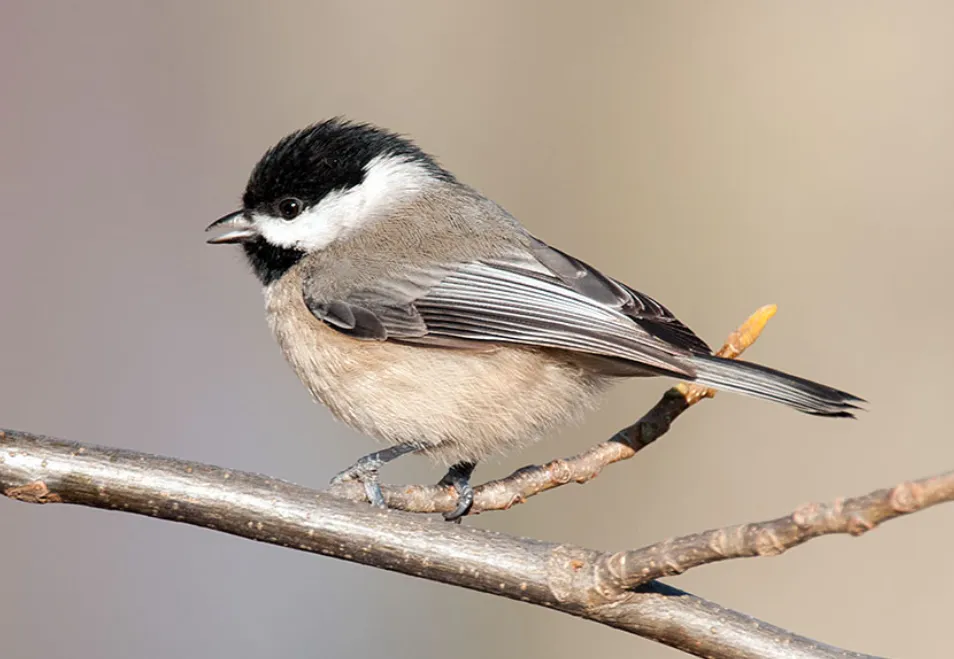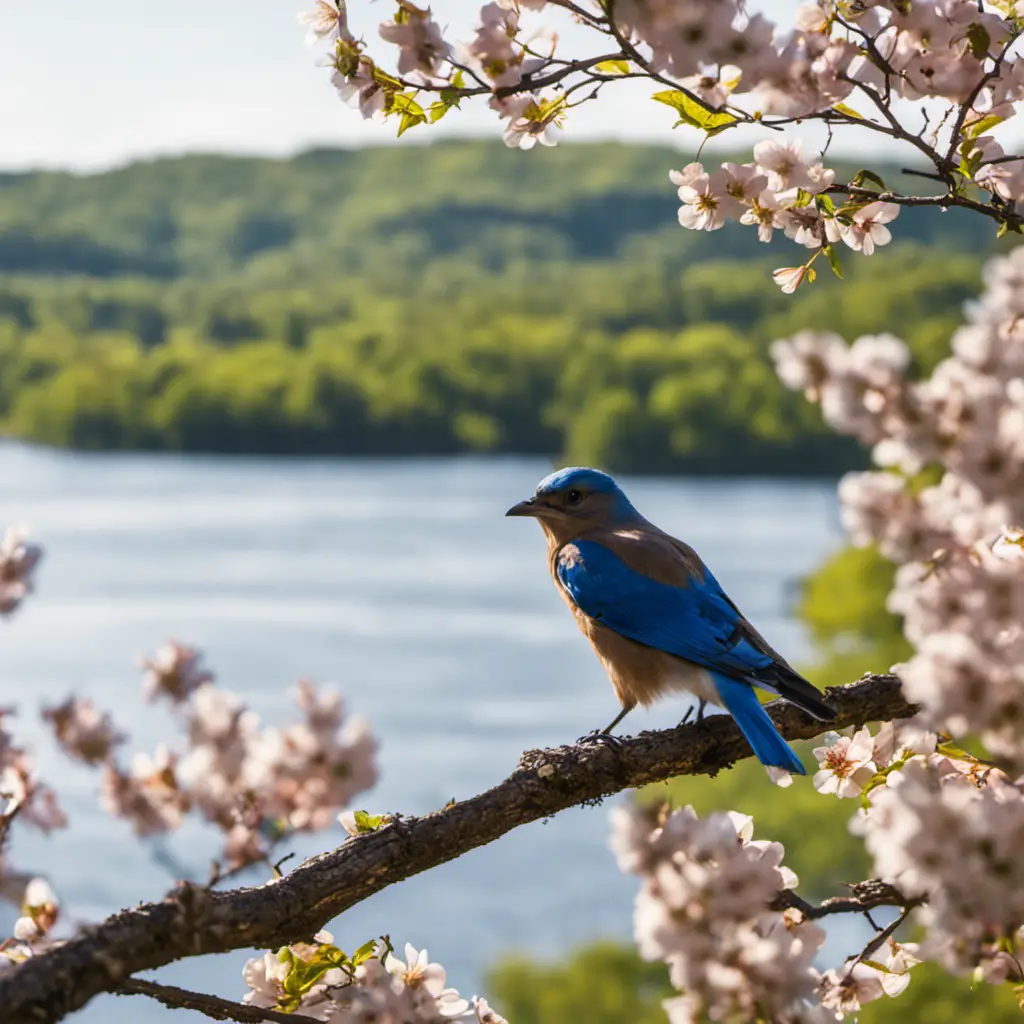Welcome to the fascinating world of birds in Oklahoma! In this article, you’ll discover a diverse array of species that call this state home.
From the elegant Scissor-tailed Flycatcher to the resilient House Sparrow, Oklahoma is a haven for avian enthusiasts. Keep your eyes to the sky and be amazed by the majestic Turkey Vulture, the melodic Northern Mockingbird, and the powerful Red-tailed Hawk.
Prepare to be captivated by the graceful Great Egret, the wise Great Horned Owl, the majestic Herring Gull, and the charming Lark Sparrow.
Let’s embark on this avian adventure together!
Key Takeaways
- Scissor-tailed Flycatchers have distinctive scissor-like tail feathers and perform aerial displays to attract mates.
- House Sparrows are adaptable nesters and breed from early spring to mid-summer, laying multiple eggs per clutch.
- Northern Mockingbirds are known for their vocal mimicry behavior and form long-term pair bonds.
- Turkey Vultures are migratory birds that play an important role in ecosystems by cleaning up decaying animal matter.
Scissor-tailed Flycatcher
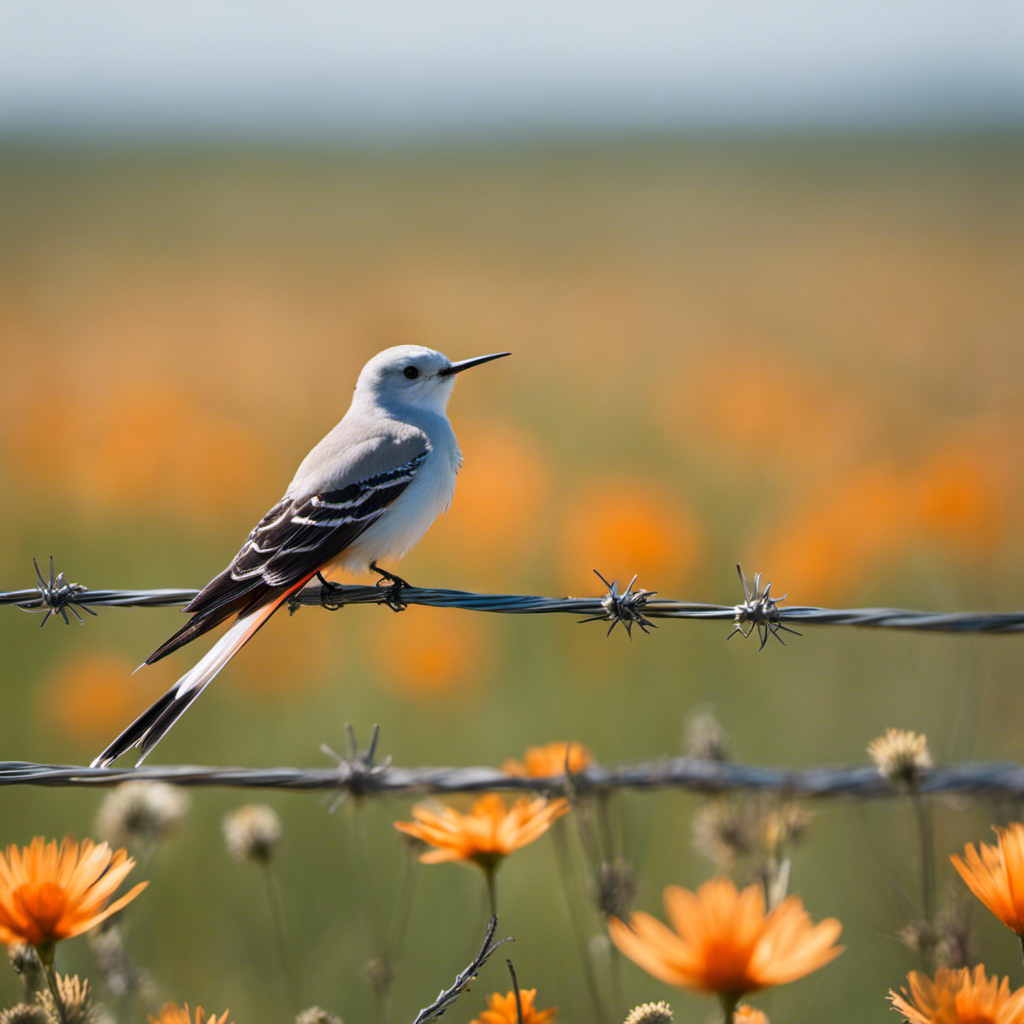
You should look for the Scissor-tailed Flycatcher in Oklahoma during the spring migration. This bird is known for its distinctive scissor-like tail feathers, which are longer in males than in females.
The Scissor-tailed Flycatcher has interesting migration patterns. They spend their winters in southern Mexico and Central America, and then migrate to the southern United States, including Oklahoma, to breed during the spring.
During this time, they engage in unique mating behaviors. Male Scissor-tailed Flycatchers perform elaborate aerial displays to attract females. They fly high in the sky and make impressive dives and twists, showcasing their long tail feathers. The female then chooses a mate based on the performance of these displays.
Watching these fascinating behaviors during the spring migration is an experience not to be missed.
House Sparrow
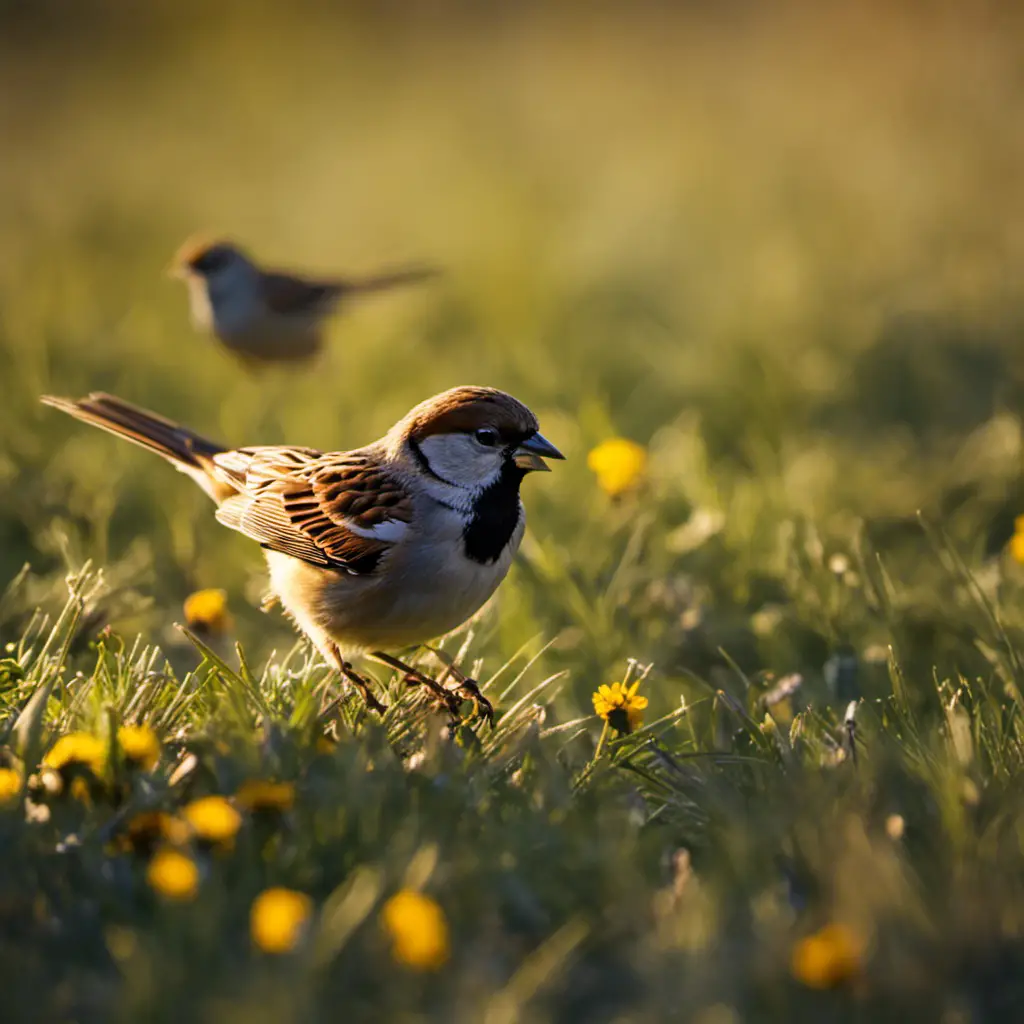
Have you noticed the House Sparrow nesting in your backyard? These small birds are common sights in urban and suburban areas across the United States, including Oklahoma. Here are four interesting facts about their nesting habits:
Nesting sites: House Sparrows are adaptable and will nest in a variety of locations, including tree cavities, birdhouses, and even in the eaves and crevices of buildings.
Nest construction: The female House Sparrow takes the lead in constructing the nest, using materials such as grass, twigs, feathers, and even bits of trash.
Breeding season: House Sparrows typically breed from early spring through mid-summer, with females laying 3-7 eggs in each clutch.
Sparrow conservation efforts: While House Sparrows aren’t endangered, they’ve faced some decline in certain areas. To help conserve these birds, it’s important to provide suitable nesting sites, control predator populations, and minimize the use of pesticides.
Turkey Vulture
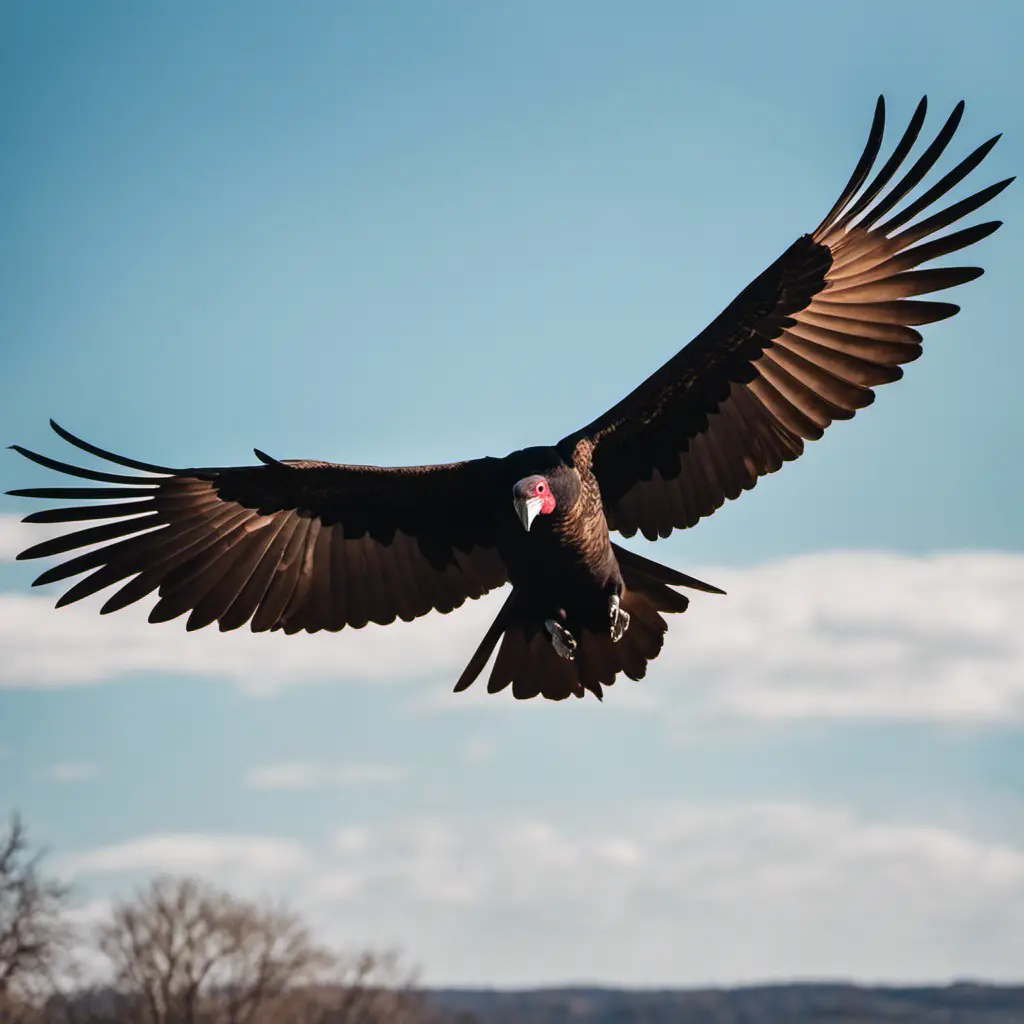
Do you ever see turkey vultures soaring in the sky above Oklahoma? These remarkable birds are a common sight in the state, known for their distinctive appearance and behavior. Turkey vultures are migratory birds, traveling long distances in search of food. They have a wide range, with breeding grounds in North America and wintering grounds in Central and South America. In Oklahoma, they can be seen during migration periods, usually in the spring and fall.
Feeding habits of turkey vultures are fascinating. They are carrion eaters, meaning they primarily feed on dead animals. Their keen sense of smell allows them to locate carcasses from great distances. Once they find a meal, turkey vultures use their strong beaks to tear open the flesh and consume it. They play an important role in the ecosystem by helping to clean up decaying animal matter.
Northern Mockingbird
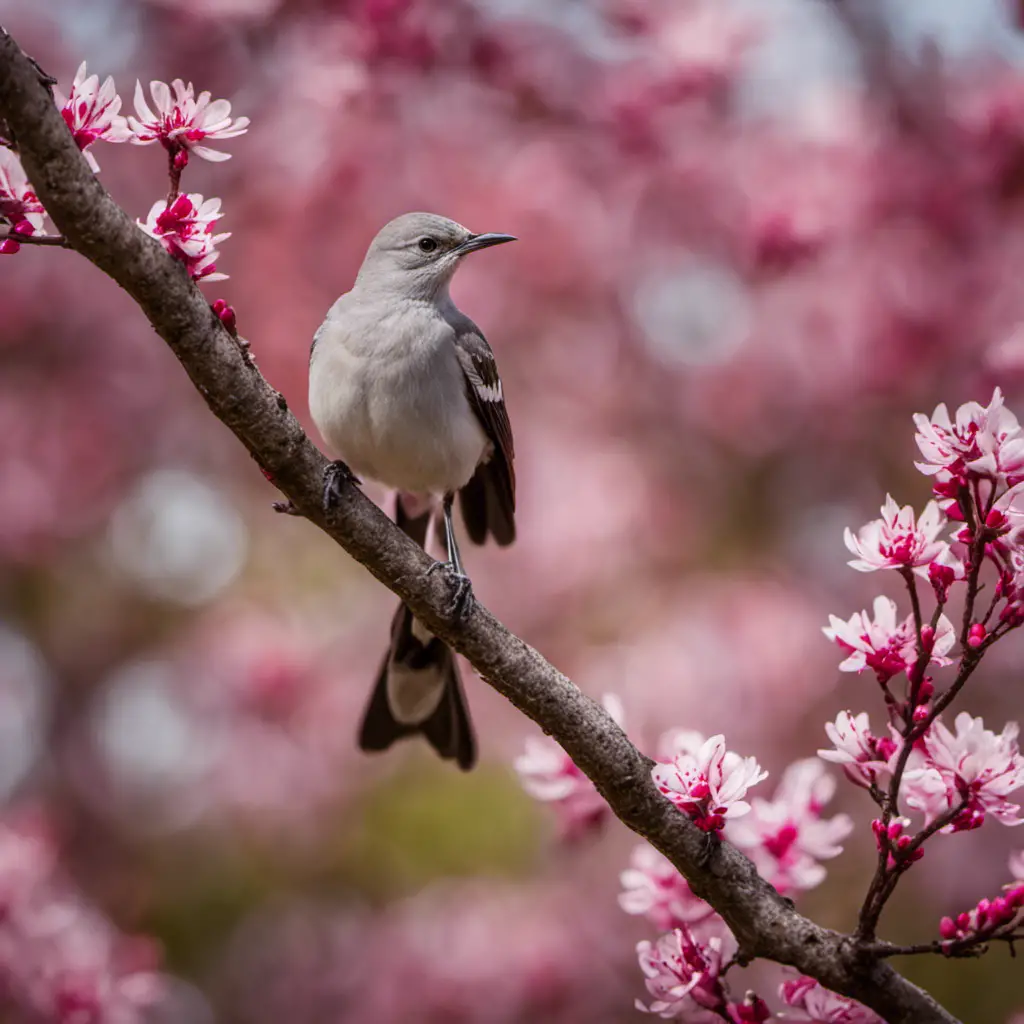
Spotting not one, but two Northern Mockingbirds in your backyard can be quite a treat. These birds are known for their remarkable vocal mimicry behavior, which allows them to imitate the calls of other birds and even non-avian sounds. They’ve a vast repertoire of songs and can mimic up to 200 different species.
When it comes to breeding habits, Northern Mockingbirds are monogamous and form long-term pair bonds. The female builds the nest, usually in dense shrubs or trees, using twigs, grass, and other materials. They lay a clutch of 2-6 eggs, which are incubated by the female for about two weeks. Both parents then take turns feeding and protecting the nestlings until they fledge at around two weeks old.
These fascinating behaviors make the Northern Mockingbird a captivating species to observe in your backyard.
Red-tailed Hawk
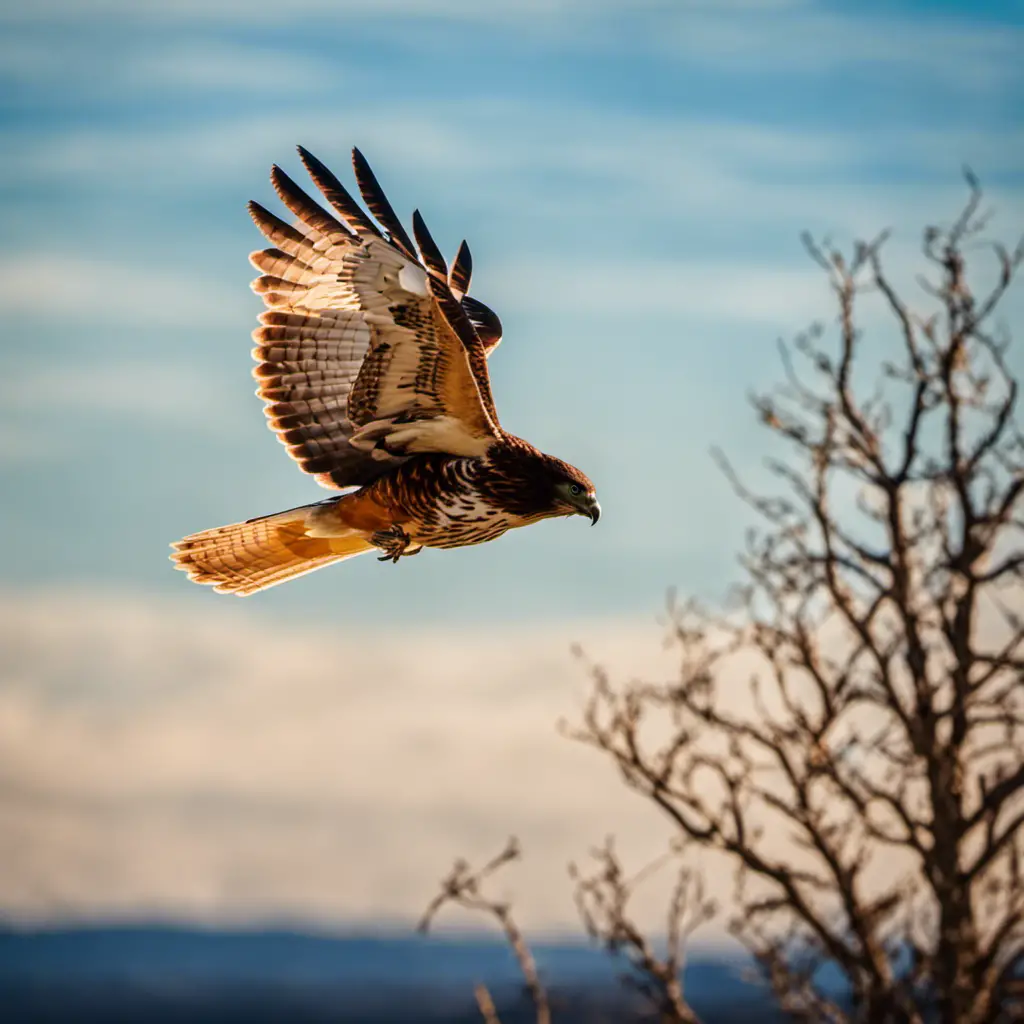
You can admire the majestic beauty of the Red-tailed Hawk as it soars gracefully through the sky. This bird is a large raptor that can be found in various habitats across North America, including Oklahoma.
The Red-tailed Hawk is known for its distinctive red tail feathers, which give it its name. In terms of behavioral patterns, these hawks are primarily solitary birds, although they may form small groups during migration. They’re skilled hunters and commonly prey on small mammals, birds, and reptiles.
When it comes to habitat preferences, Red-tailed Hawks are adaptable and can be found in a wide range of environments, including open fields, forests, and deserts. They typically build their nests in tall trees or on cliffs, and they prefer areas with ample prey availability.
Overall, the Red-tailed Hawk is a fascinating and adaptable bird species that has adapted to various habitats and displays unique behavioral patterns.
American Goldfinch
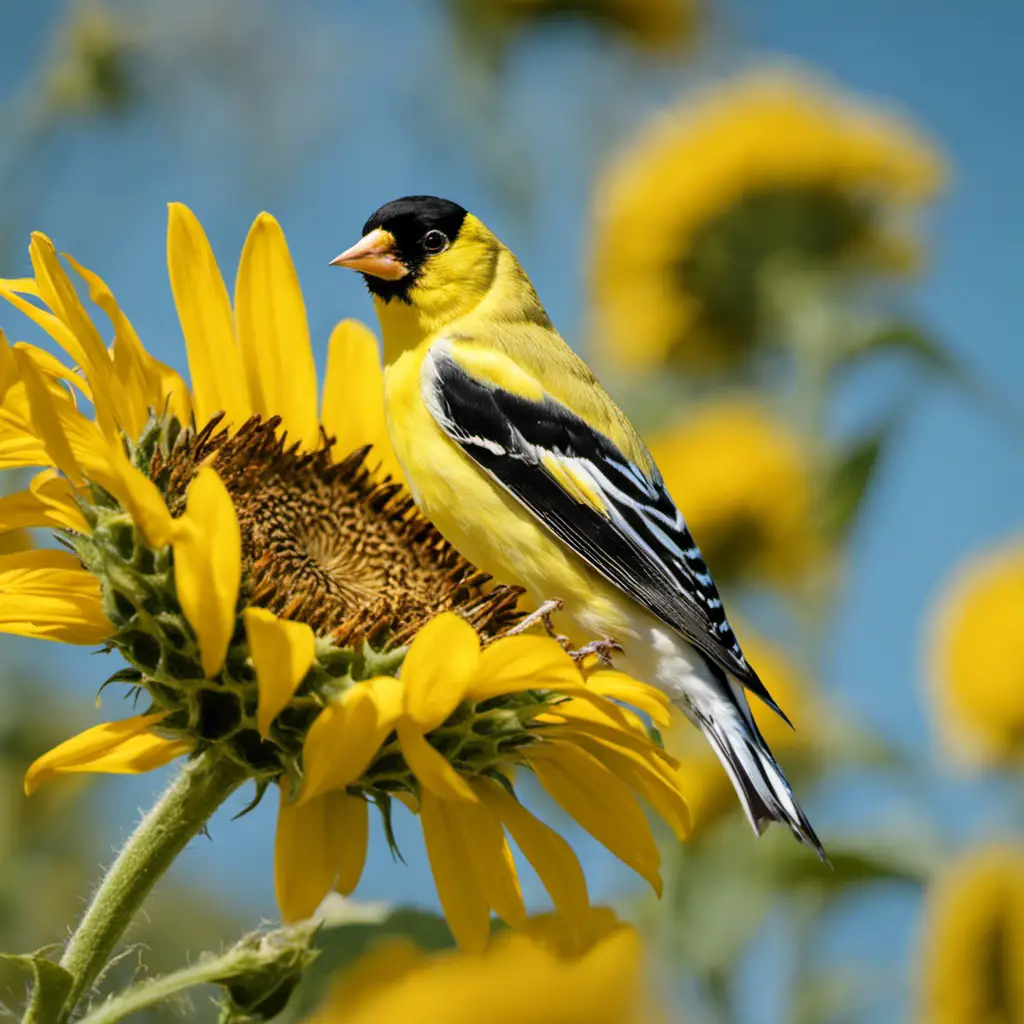
You may have already noticed that American Goldfinches are starting to appear in your backyard during the summer months. These charming little birds are a delight to observe with their bright yellow plumage and distinctive black wings.
Here are a few interesting facts about the American Goldfinch:
Habitat: American Goldfinches are commonly found in open fields, meadows, and gardens. They prefer areas with tall grasses and flowering plants, as they rely heavily on seeds for their diet.
Diet: Speaking of diet, American Goldfinches have a preference for seeds, especially those from thistles, sunflowers, and dandelions. They’ve a unique adaptation that allows them to extract seeds from plants that other birds can’t access.
Breeding: American Goldfinches are late breeders compared to other songbirds. They typically start nesting in June or July when their preferred food sources are abundant.
Migration: Unlike some other birds, American Goldfinches don’t migrate long distances. They’re considered partial migrants, with some populations staying year-round and others migrating south during the winter.
American Robin
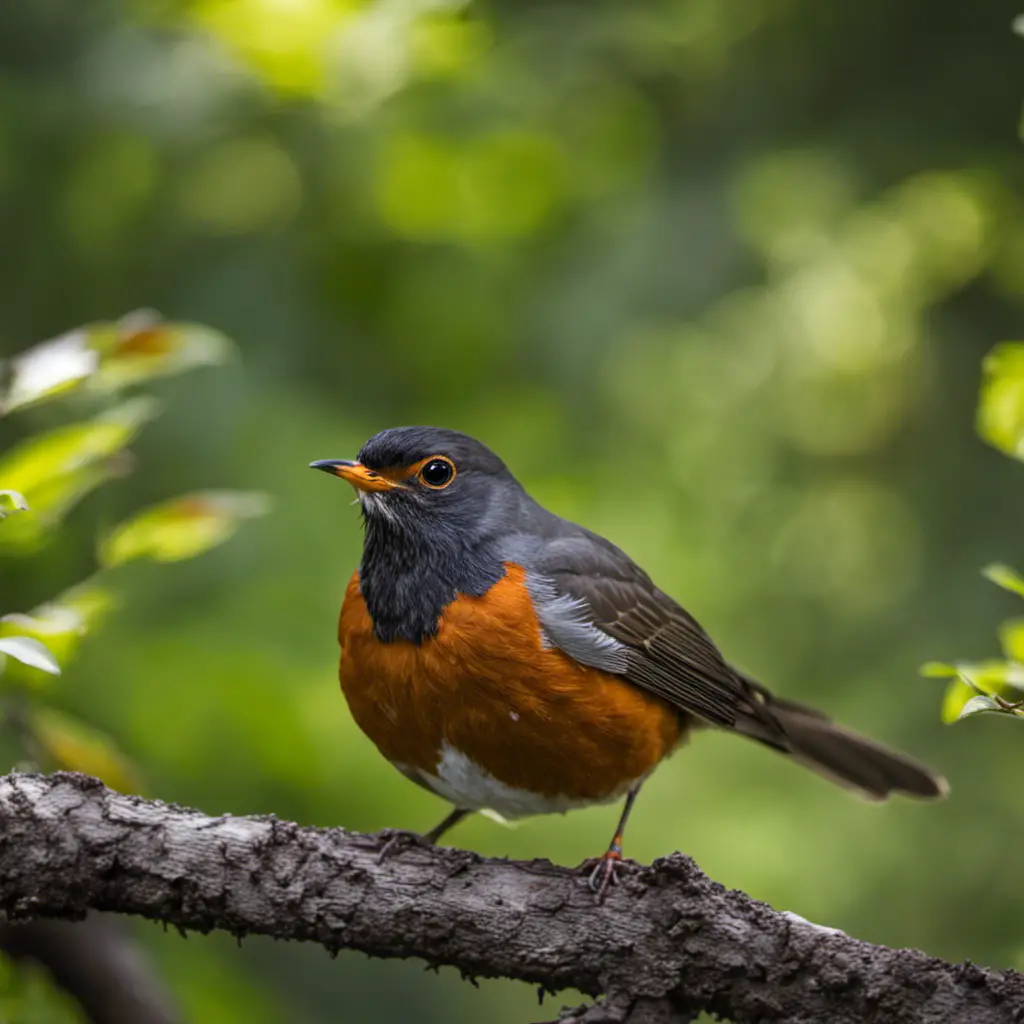
If you’re lucky, you might spot an American Robin building its nest in your backyard this spring. American Robins are known for their distinctive reddish-orange breast and are one of the most common songbirds in North America.
During the winter, they typically migrate south in search of food, but as temperatures rise, they start their journey back to their breeding grounds. These migration patterns vary depending on the region, with some robins staying year-round in warmer areas.
In urban areas, American Robins have adapted well to human environments. They’re highly adaptable and can be found nesting in trees, shrubs, and even on man-made structures. They’re also known to feed on fruits and worms found in gardens and lawns.
Mourning Dove
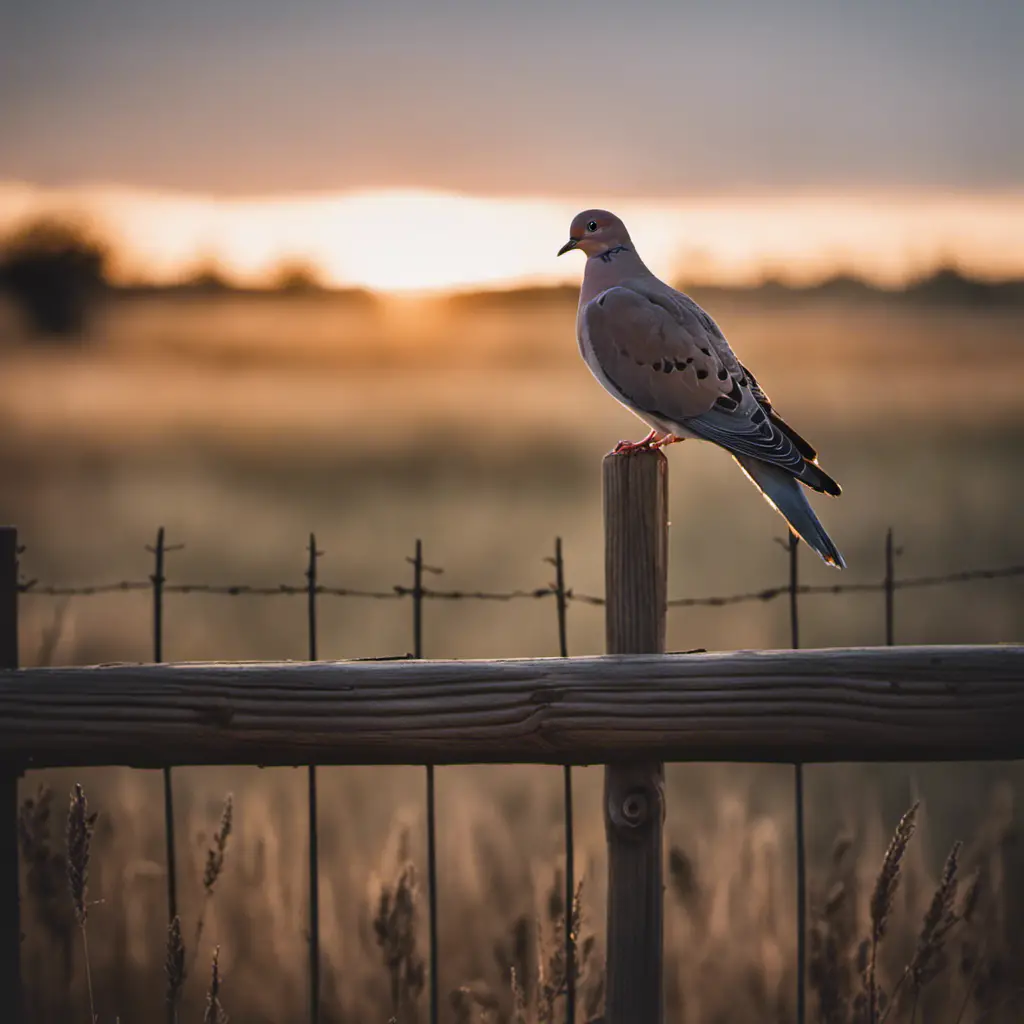
Spotting a Mourning Dove on your backyard fence is a sign that spring has arrived, for they often perch there or on tree branches to coo and mate. These gentle birds are known for their distinctive soft cooing sound, which is a key part of their mating behavior.
Here are four discussion ideas about Mourning Doves:
Mourning dove migration patterns: These birds are migratory, with their range extending across North America. They typically migrate during the fall and spring, with some populations traveling long distances to reach their breeding grounds.
The mating behavior of mourning doves: Mourning Doves form monogamous pairs and mate for life. During courtship, the male performs a display flight, where he flies in a circular pattern while making a soft cooing sound. This display is intended to attract a female mate.
Nesting habits: Mourning Doves build flimsy nests made of twigs, grass, and leaves. The nests are often located in trees, shrubs, or on man-made structures. The female lays two white eggs, which both parents take turns incubating.
Diet and feeding habits: Mourning Doves primarily feed on seeds, grains, and fruits. They forage on the ground, often in large flocks, and use their specialized beak to remove the husk from seeds before consuming them.
Understanding these aspects of Mourning Doves can provide a deeper appreciation for these beautiful birds and their important role in the ecosystem.
Blue Jay
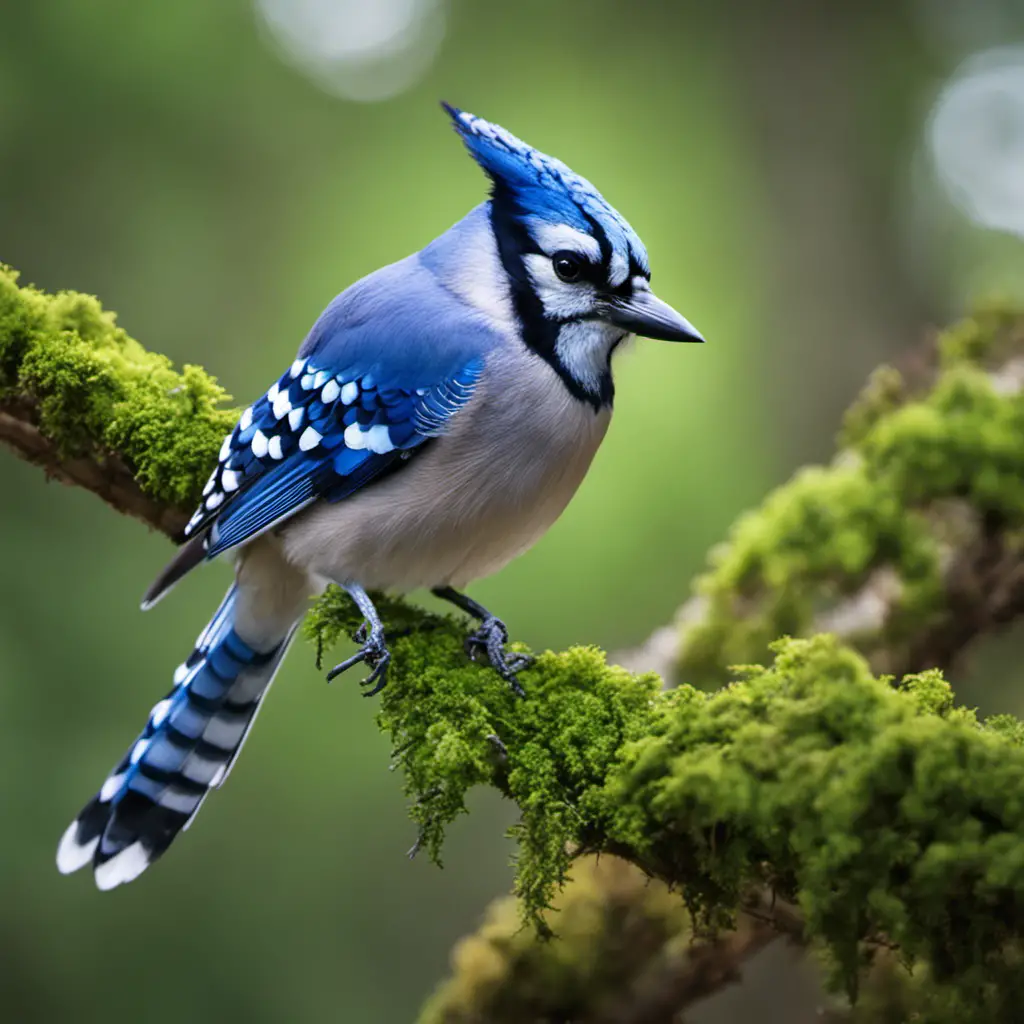
Have you seen a Blue Jay in your backyard lately? Blue Jays, scientifically known as Cyanocitta cristata, are native to North America and can be found in various habitats including forests, woodlands, parks, and even residential areas.
These striking birds are easily recognizable by their vibrant blue plumage, white chest, and black markings on their wings and tail. Blue Jays are known for their distinctive calls, often imitating the calls of other birds and even mimicking human voices.
They’re highly intelligent and have complex social behaviors, living in small family groups or large flocks depending on the season. Blue Jays are omnivorous, feeding on a wide range of food including nuts, seeds, insects, and occasionally small vertebrates. They’re also known for their habit of caching food, storing it for later consumption.
Eastern Bluebird

Do you know where to find an Eastern Bluebird in your area? These beautiful birds can be found across North America, including in Oklahoma. Here are four key points about Eastern Bluebird conservation, behavior, and migration patterns:
Conservation efforts: Eastern Bluebirds have faced habitat loss and competition from invasive species. Conservation initiatives, such as the installation of nesting boxes and the preservation of open grasslands, have helped increase their populations.
Breeding behavior: Eastern Bluebirds are cavity nesters and prefer open habitats with nearby trees or fence posts for perching. Males attract females by singing and displaying their bright blue plumage. They build nests using grasses and feathers.
Migration patterns: Eastern Bluebirds are partially migratory. While some individuals stay year-round in their breeding territories, others migrate south during the winter months to find more abundant food sources.
Diet and feeding behavior: Eastern Bluebirds mainly feed on insects, including beetles, grasshoppers, and spiders. They also eat fruits and berries, especially during the winter when insects are scarce.
Understanding these aspects of Eastern Bluebird conservation, behavior, and migration patterns can help us appreciate and protect these delightful birds in our area.
Great Blue Heron
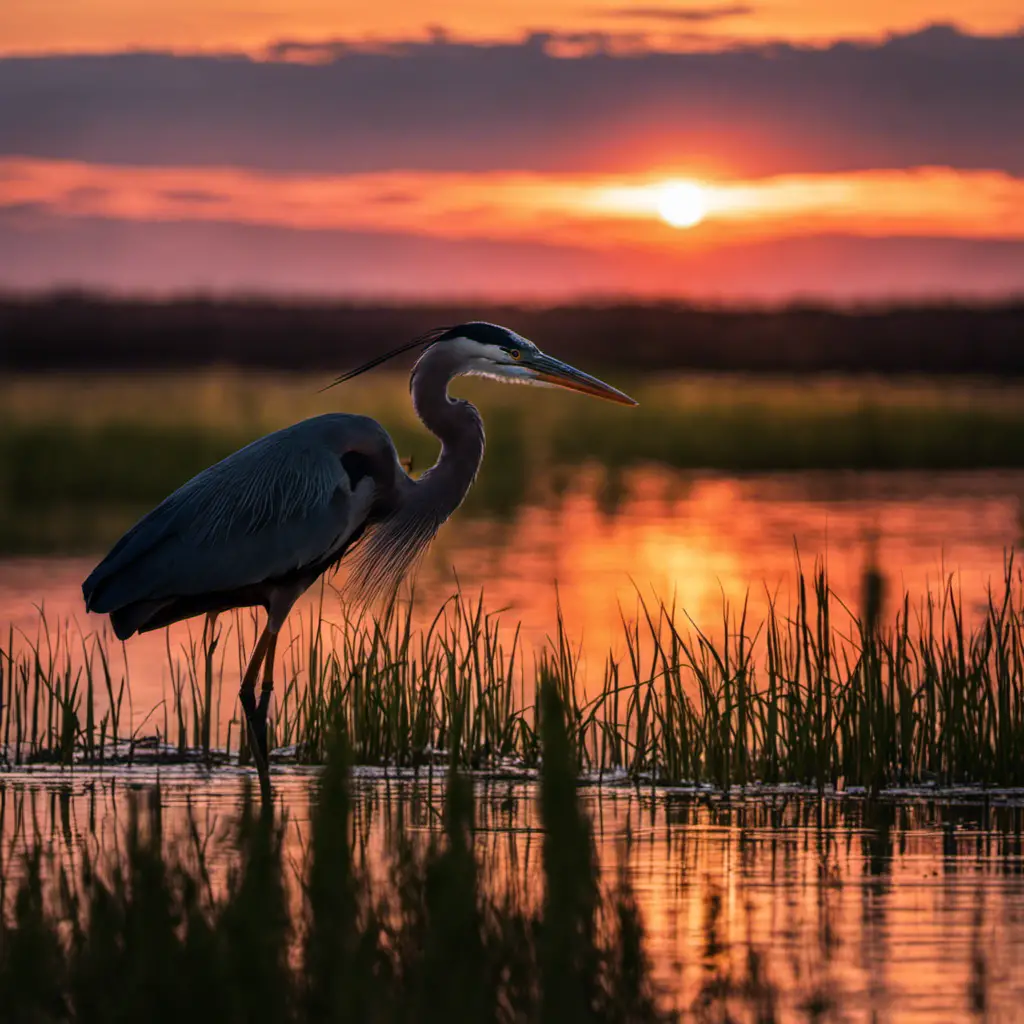
Have you seen the Great Blue Heron flying gracefully over the water? This majestic bird, with its distinct blue-gray plumage and long legs, is a sight to behold. The Great Blue Heron is a common resident in wetland habitats across North America, including Oklahoma. It can be found in marshes, swamps, and along the shores of lakes and rivers.
Discussion ideas regarding the Great Blue Heron could include its migratory patterns and the importance of habitat preservation. This bird is known for its impressive long-distance migrations, as it travels between breeding and wintering grounds. Understanding these migratory patterns can help in conserving their populations and protecting their habitats along their routes.
Habitat preservation plays a crucial role in ensuring the survival of the Great Blue Heron. These birds rely on healthy wetlands for nesting, feeding, and raising their young. By protecting and restoring wetland ecosystems, we can ensure the continued presence of the Great Blue Heron and other wetland-dependent species.
Killdeer
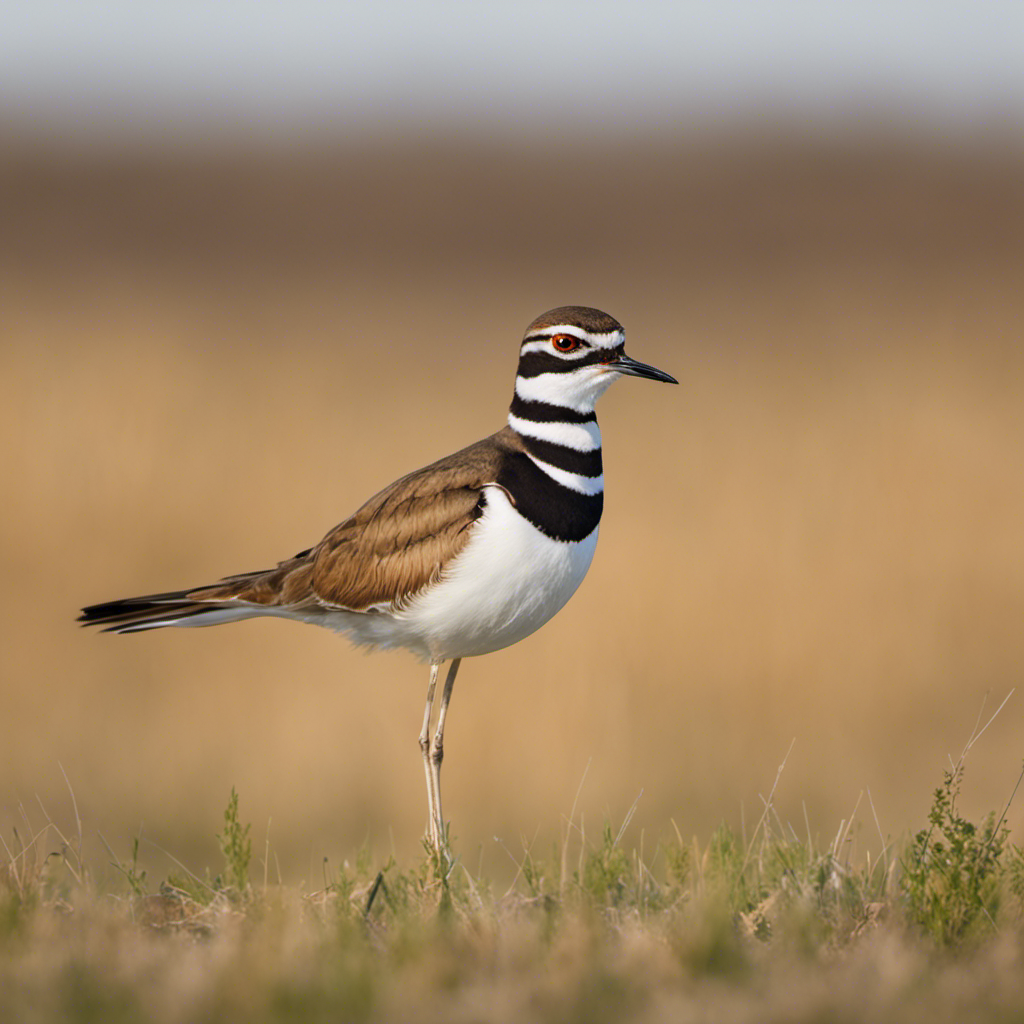
You might spot several Killdeer nests in the grassy areas near the water. These small, migratory birds are known for their distinctive markings and unique behaviors. Here are some key points to consider about Killdeer:
Nesting habits and behaviors: Killdeer usually build their nests on the ground, often in open areas such as fields or gravel rooftops. They use a variety of materials, including pebbles and plant stems, to construct their nests. The female lays 3-5 eggs, which are well-camouflaged to blend in with the surroundings. Killdeer are known for their ‘broken wing’ display, where they pretend to have a broken wing to distract predators from their nests.
Conservation efforts: The killdeer population in Oklahoma is currently stable, but conservation efforts are still important to ensure their long-term survival. Preservation of suitable nesting habitats, such as open fields and grassy areas near water bodies, is crucial. Efforts to reduce disturbances at nesting sites, such as avoiding off-road vehicles or keeping dogs on leashes, can also help protect killdeer populations.
Northern Cardinal
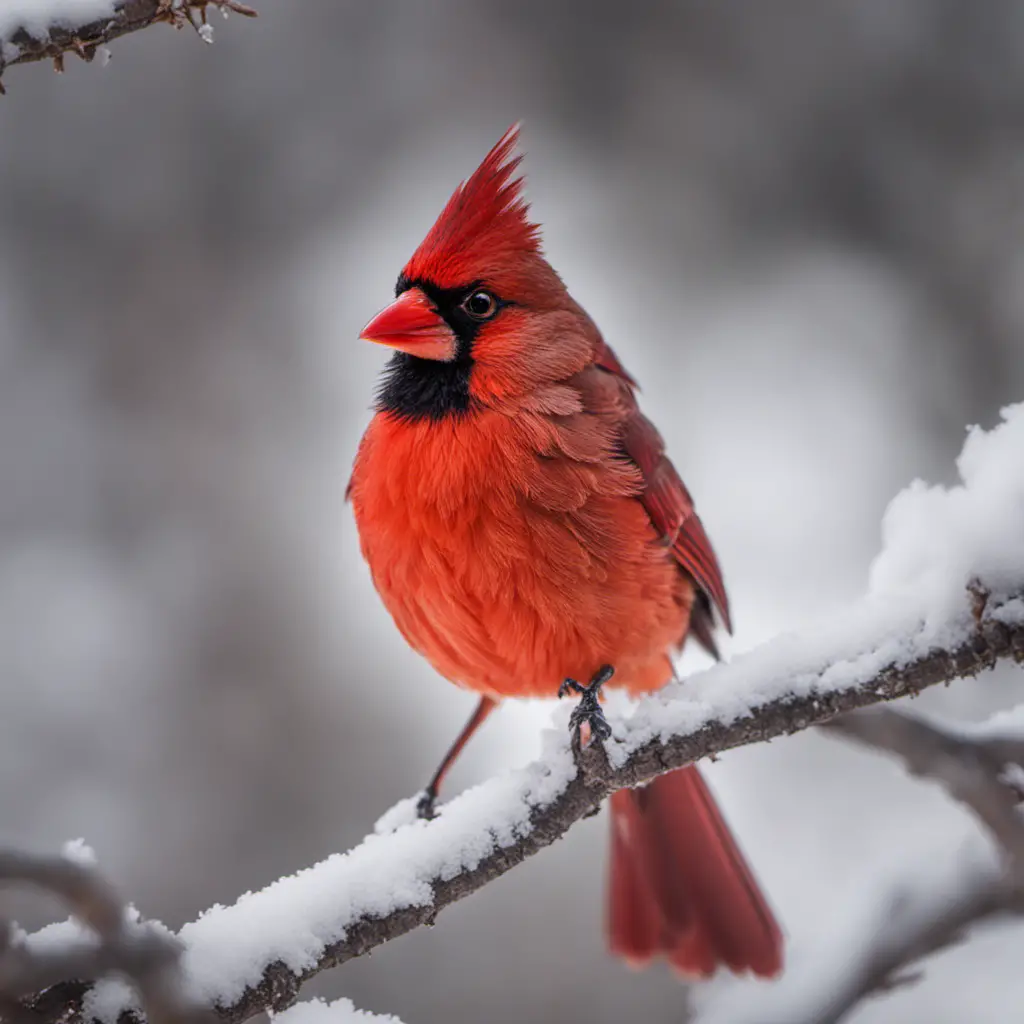
If you look closely, you’ll notice that the vibrant red plumage of the Northern Cardinal stands out among the branches.
The Cardinal, scientifically known as Cardinalis cardinalis, is a common bird species found throughout North America, including Oklahoma.
Cardinals are known for their distinctive red coloration, with the males being bright red and the females displaying a more muted brownish-red color.
They’re primarily found in woodland habitats, such as forests, thickets, and gardens, where they can find a combination of trees for nesting and open areas for foraging.
Cardinals are also known for their behavior, such as their territorial nature, with males defending their breeding territories through song and aggressive displays.
They’re primarily seed-eaters but also consume insects and fruits.
The Northern Cardinal is a popular bird among birdwatchers and backyard bird enthusiasts due to its striking appearance and beautiful song.
American Crow
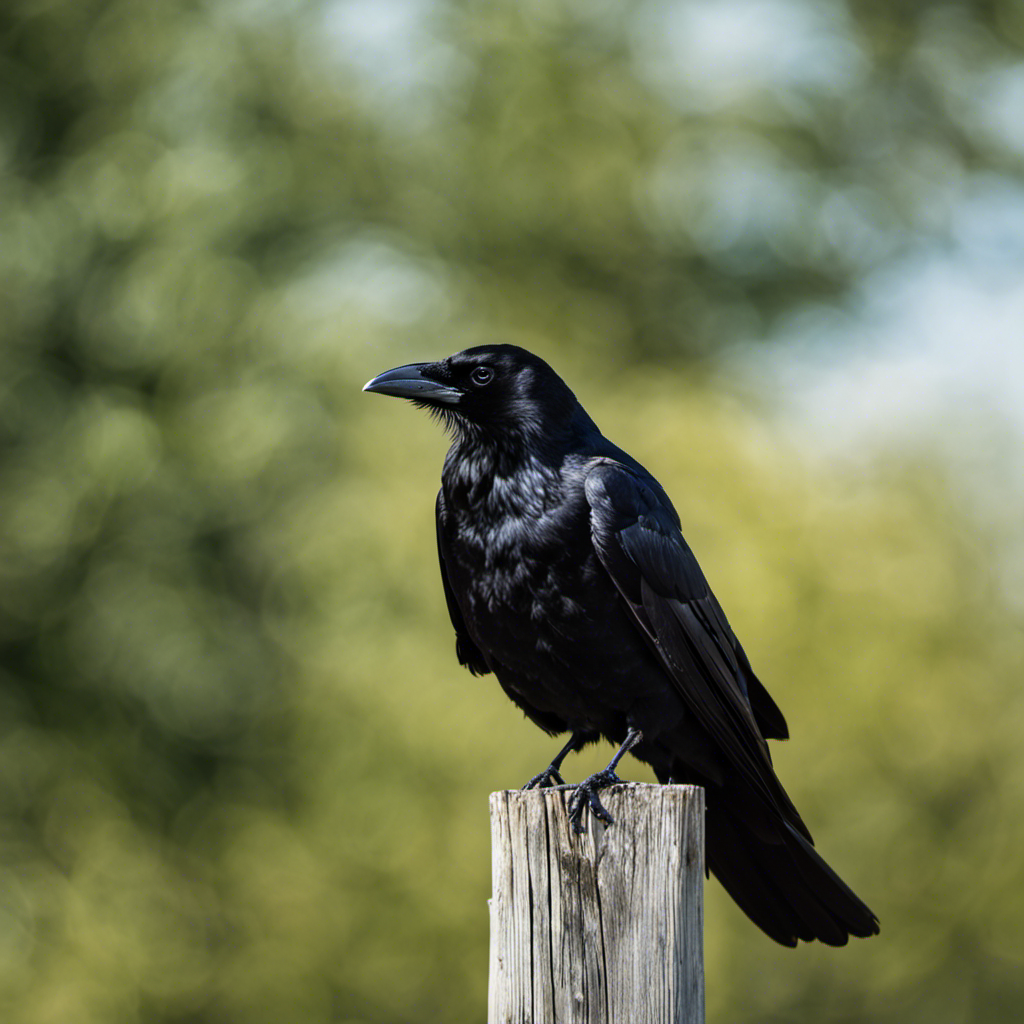
Did you know that the American Crow, also known as Corvus brachyrhynchos, is a highly intelligent bird? Here are four fascinating facts about their behavioral patterns and habitat preferences:
Tool usage: American Crows have been observed using tools to obtain food. They can fashion tools from twigs and use them to extract insects from tree bark or probe the ground for prey.
Social behavior: Crows are highly social birds and often form large groups called roosts. These roosts provide protection from predators and allow them to share information about food sources.
Adaptability: American Crows are incredibly adaptable and can thrive in a variety of habitats, including forests, fields, and urban areas. They’re opportunistic feeders, consuming a wide range of food, from fruits and seeds to small mammals and carrion.
Problem-solving skills: Studies have shown that crows possess remarkable problem-solving abilities. They can quickly learn and remember complex tasks, such as using multiple steps to obtain food rewards.
Understanding the behavioral patterns and habitat preferences of American Crows can provide valuable insights into their ecological role and help in their conservation efforts.
Brown-headed Cowbird
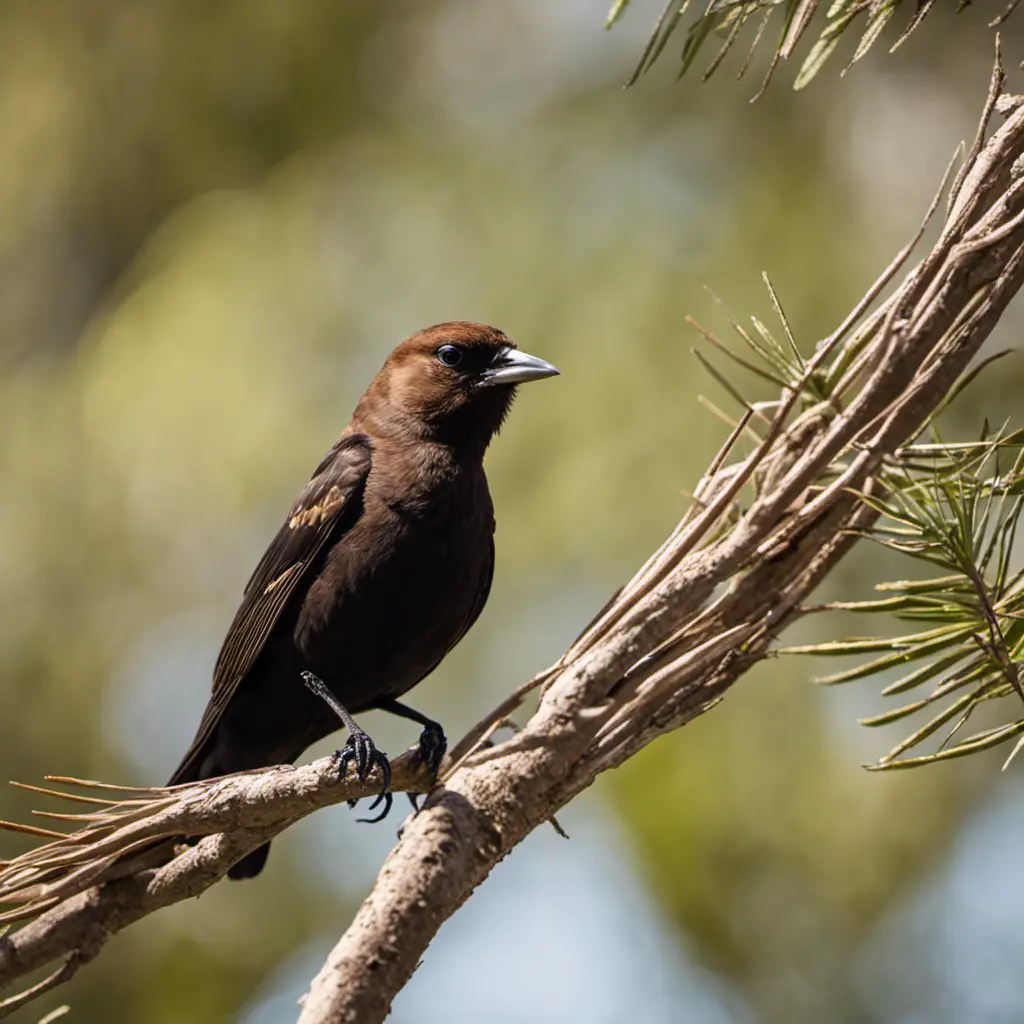
During the breeding season, the Brown-headed Cowbird lays its eggs in the nests of other bird species and relies on them to raise its young. This behavior, known as brood parasitism, allows the cowbird to save energy and invest more in producing eggs.
The female cowbird selects a suitable host nest and quickly lays her eggs, often removing the host’s eggs in the process. The cowbird eggs are then incubated and cared for by the unsuspecting host parents.
This behavioral characteristic is unique to cowbirds and has both advantages and disadvantages. While it ensures the survival of cowbird offspring, it can negatively impact the host species, as they may raise fewer of their own young.
Brown-headed Cowbirds are primarily found in open habitats such as grasslands, fields, and forest edges. They prefer areas with scattered trees or shrubs, which provide suitable nesting sites and foraging opportunities.
Cedar Waxwing
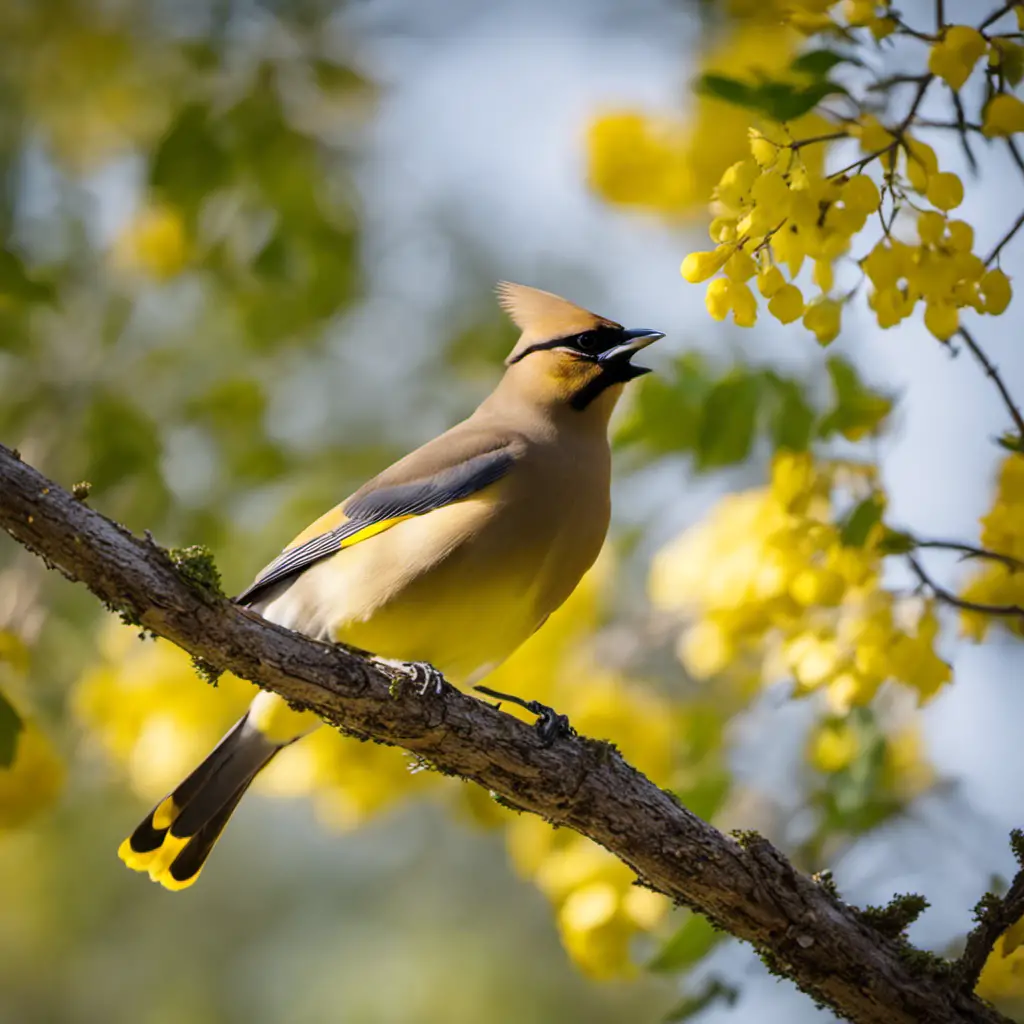
You can easily identify a Cedar Waxwing by its sleek, brownish-gray plumage and its distinctive crest. Here are four fascinating facts about this beautiful bird:
Habitat and Diet: Cedar waxwings are commonly found in open woodlands, parks, and orchards throughout North America. They’re known for their preference for fruits, especially berries, which make up a significant portion of their diet. They also feed on insects, nectar, and flower petals.
Breeding Behavior: Cedar waxwings are monogamous birds that form strong pair bonds. They typically breed in the late spring and early summer. The female builds a cup-shaped nest made of twigs, grass, and moss, usually in a tree or shrub. Both parents take turns incubating the eggs and caring for the chicks.
Courtship Rituals: During courtship, male cedar waxwings perform elaborate flight displays, flying back and forth with their wings and tail spread wide. They also engage in ‘passing’ behavior, where they pass a berry or insect back and forth with their potential mate.
Social Behavior: Cedar waxwings are highly social birds that often gather in large flocks, especially during the winter. They communicate using soft, high-pitched calls and are known for their synchronized feeding behavior, where they line up on branches and pass berries or insects down the line.
Understanding these aspects of the cedar waxwing’s habitat, diet, breeding behavior, and courtship rituals allows us to appreciate the complexity of their lives and the importance of conserving their natural habitats.
Chipping Sparrow
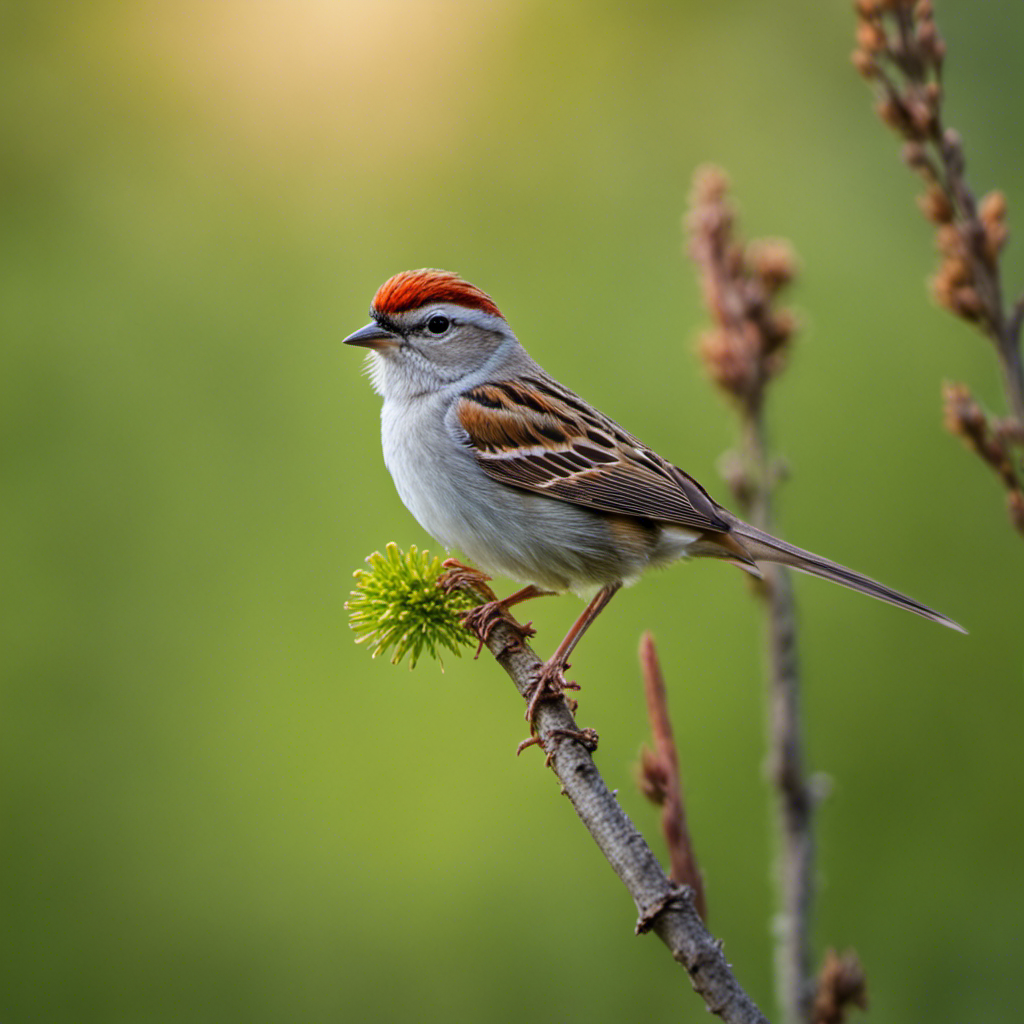
There are two common types of sparrows in Oklahoma: the Chipping Sparrow and the Field Sparrow. Today, we’ll focus on the Chipping Sparrow and explore its nesting habits, diet, and feeding behavior.
Chipping Sparrows are small, colorful birds that can be found across North America, including Oklahoma. They’re known for their distinctive ‘chipping’ song, which is often heard during the breeding season.
Chipping Sparrows typically build their nests in shrubs, trees, and sometimes even in hanging baskets or flower pots. They construct cup-shaped nests using a variety of materials, including twigs, grass, and feathers. These nests provide a safe and secure environment for their eggs and young.
In terms of diet, Chipping Sparrows primarily feed on insects, seeds, and berries. They forage on the ground, hopping and scratching the leaf litter in search of food. They also have a preference for small seeds, such as those from grasses and weeds.
Overall, Chipping Sparrows are fascinating birds with unique nesting habits and a diverse diet. By understanding their behavior and needs, we can better appreciate and protect these beautiful creatures.
Common Grackle
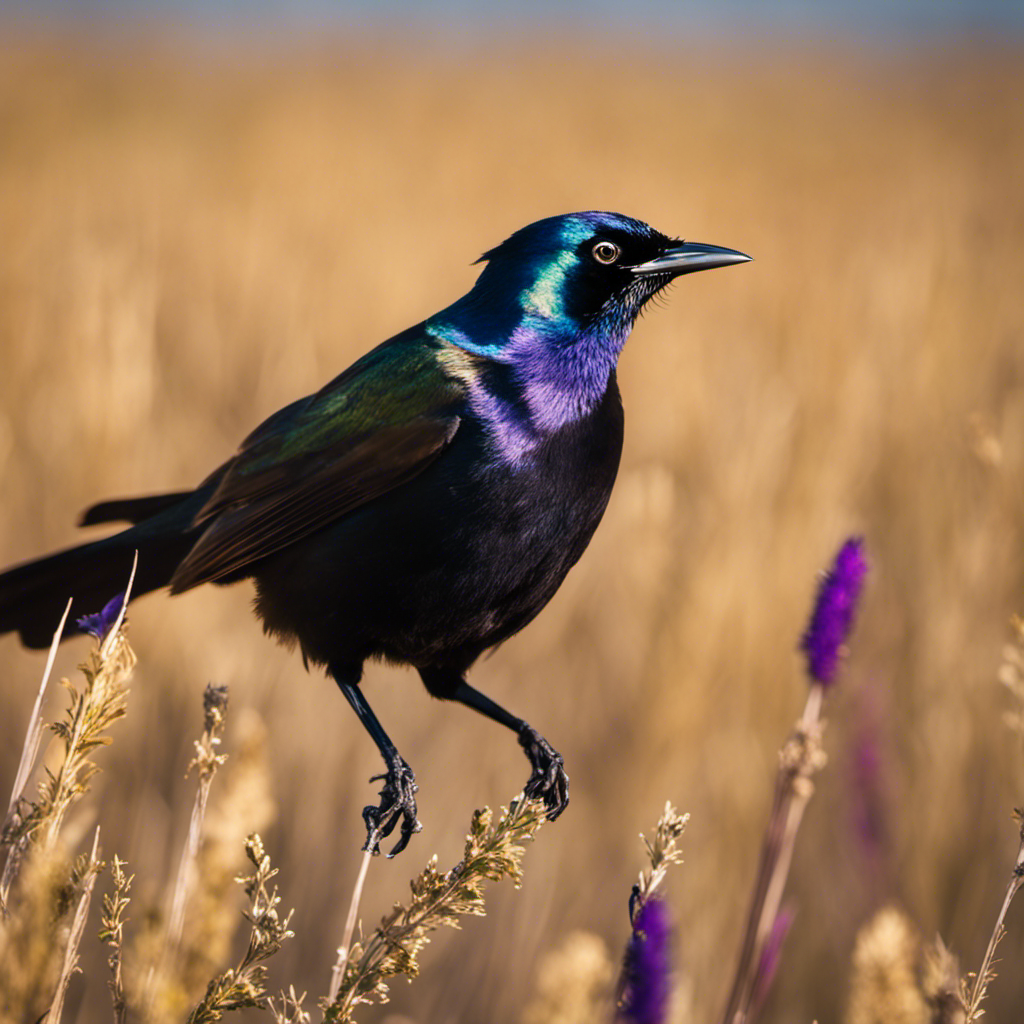
Don’t miss the opportunity to observe the Common Grackle’s unique iridescent plumage and hear its raucous calls. This fascinating bird, found in Oklahoma, has distinct habitat preferences and interesting breeding behavior.
Here are four key points to understand about the Common Grackle:
Habitat preferences: Common Grackles are highly adaptable and can be found in a variety of habitats, including woodlands, wetlands, farmlands, and urban areas. They’re often seen near water bodies such as lakes, ponds, and rivers.
Breeding behavior: Common Grackles are monogamous and form pair bonds during the breeding season. They build nests in trees, usually near water, using twigs, grass, and mud. The female lays 3-7 eggs and both parents take turns incubating them.
Nest defense: Common Grackles are fiercely protective of their nests and will aggressively defend them against potential predators, including other birds and mammals.
Vocalizations: Common Grackles are known for their loud and raucous calls, which are often heard during breeding season and when they gather in large flocks. Their vocalizations serve various purposes, including communication, territorial defense, and attracting mates.
Understanding the habitat preferences and breeding behavior of the Common Grackle can provide valuable insights into its ecology and contribute to the conservation efforts of this remarkable species.
Double-crested Cormorant

Take a closer look at the Double-crested Cormorant’s unique diving abilities, as it hunts for fish underwater with precision.
The double crested cormorant is a large water bird that can be found in various freshwater and marine habitats across North America.
Its fishing behavior is truly remarkable, as it has adapted to be an efficient underwater predator. With its long, slender body and webbed feet, the cormorant is built for swimming and diving. It can stay submerged for extended periods of time, using its strong wings to propel itself underwater. The cormorant’s beak is sharp and hooked, allowing it to catch and grip fish securely.
In terms of breeding habits, double crested cormorants are colonial nesters, often forming large breeding colonies on trees or rocky cliffs. During the breeding season, males display elaborate courtship behaviors, including wing-flapping and vocalizations, to attract mates.
These fascinating birds provide a captivating glimpse into the world of avian fishing behavior and breeding habits.
Downy Woodpecker
You can easily identify the Downy Woodpecker by its black and white plumage, and it’s often seen pecking at tree trunks in search of insects. This small bird, measuring about 6-7 inches in length, has a wingspan of around 10-12 inches.
Here are some interesting facts about the Downy Woodpecker:
Behavior: The Downy Woodpecker is known for its drumming behavior, which involves rapid pecking on tree trunks to establish territory and attract mates. It also uses its bill to excavate nest cavities in dead or decaying trees.
Habitat: This woodpecker species is commonly found in forests, woodlands, and suburban areas across North America, including Oklahoma. It prefers habitats with a mix of open spaces and trees for foraging and nesting.
Nesting Habits: The Downy Woodpecker constructs its nest by excavating a hole in a tree, usually between 4-60 feet above the ground. The female lays 3-8 white eggs, which both parents take turns incubating for about 12 days.
Diet: The Downy Woodpecker primarily feeds on insects, including beetles, ants, and caterpillars, which it extracts from bark crevices using its long, barbed tongue. It also consumes seeds and berries during the winter months when insects are scarce.
Understanding the behavior, habitat, and nesting habits of the Downy Woodpecker contributes to our knowledge of this fascinating bird species.
European Starling
If you observe closely, you’ll notice that the European Starling has a glossy black plumage with iridescent green and purple tones, and it’s known for its distinctive and melodic song.
The behavior patterns of the European Starling are quite interesting. They’re highly social birds and often form large flocks, especially during the non-breeding season. They’re also known to be highly adaptable and can thrive in a variety of habitats, including urban areas, farmlands, and open woodlands. However, they prefer open spaces with short grass, as it provides them with easy access to their preferred diet of insects and fruits.
European Starlings are cavity nesters and will readily use man-made structures such as buildings and nest boxes.
Overall, the European Starling is a fascinating bird with unique behavior patterns and adaptable habitat preferences.
Great Egret
When you spot a Great Egret in Oklahoma, it’s hard not to be in awe of its graceful white plumage and long, elegant neck. These magnificent birds are a common sight in the wetlands and marshes of Oklahoma, where they thrive in their natural habitats.
Here are four key points to understand about egret habitats and migration patterns:
Egret habitats: Great Egrets are typically found in freshwater and saltwater wetlands, such as marshes, swamps, and estuaries. These habitats provide an abundant supply of food, including fish, amphibians, and small invertebrates.
Breeding grounds: During the breeding season, Great Egrets gather in large colonies, often in trees or shrubs near water. These colonies, known as rookeries, provide protection from predators and ample nesting sites.
Winter migration: Great Egrets are migratory birds, and during the winter months, they often travel to warmer regions. Some individuals from Oklahoma may migrate as far south as Central and South America.
Migration patterns: Egrets typically follow a north-south migration route, with individuals from northern regions like Oklahoma traveling south for the winter. They rely on favorable weather conditions and food availability along their migration route.
Understanding egret habitats and migration patterns is crucial for their conservation and protection. By preserving their wetland habitats and ensuring safe migration routes, we can continue to admire and appreciate these breathtaking birds in Oklahoma and beyond.
Great Horned Owl
Now that we’ve discussed the Great Egret, let’s shift our focus to the Great Horned Owl, a fascinating bird species found in Oklahoma. Great Horned Owls, scientifically known as Bubo virginianus, are one of the most common and widespread owls in North America, including Oklahoma. These majestic creatures can be found in a variety of habitats across the state, including forests, woodlands, and even urban areas. They are highly adaptable and can nest in a range of locations, such as abandoned nests of other large birds, tree cavities, or even on the ground.
To better understand the habitat and nesting habits of Great Horned Owls in Oklahoma, let’s take a closer look at the following table:
| Habitat Types | Nesting Locations |
|---|---|
| Forests | Abandoned nests |
| Woodlands | Tree cavities |
| Urban areas | Ground nests |
In addition to their intriguing nesting habits, Great Horned Owls play a vital role in controlling rodent populations in Oklahoma. As opportunistic predators, they feed on a wide range of prey, including rodents like mice, rats, and voles. By actively hunting and consuming these rodents, Great Horned Owls help to regulate their populations, preventing them from reaching detrimental levels. This natural form of pest control benefits both the owls and the ecosystems they inhabit.
Herring Gull
You might be surprised to learn that there are approximately 1.5 million breeding pairs of Herring Gulls in North America. These fascinating birds have unique nesting habits and migration patterns that contribute to their successful population.
Here are four key facts about Herring Gulls:
Nesting habits: Herring Gulls typically build their nests on cliffs, rocky outcrops, or even rooftops. They construct their nests with a variety of materials, including grass, seaweed, and feathers. These nests provide protection and warmth for their eggs and hatchlings.
Migration patterns: Herring Gulls are known for their long-distance migrations. They breed in the northern regions of North America, such as Canada and Alaska, and then travel south during the winter months. Some Herring Gulls migrate as far as the Gulf of Mexico or the Caribbean.
Feeding behavior: Herring Gulls are opportunistic feeders, scavenging for food in both marine and terrestrial environments. They have a diverse diet that includes fish, crustaceans, insects, small mammals, and even garbage.
Conservation status: While the overall population of Herring Gulls is stable, some local populations have faced declines due to habitat destruction, pollution, and disturbance of nesting sites. Conservation efforts are crucial to ensure the long-term survival of these stunning birds.
Understanding the nesting habits and migration patterns of Herring Gulls allows us to appreciate their adaptability and the importance of preserving their habitats for future generations to enjoy.
Lark Sparrow
Have you seen the article about the Lark Sparrow? This fascinating bird, scientifically known as Chondestes grammacus, is found across North America, including Oklahoma. Let’s delve into its breeding habits and migration patterns.
Lark Sparrows are known for their unique breeding habits. They construct nests on the ground, often hidden amongst vegetation to provide protection from predators. Males are responsible for selecting suitable nesting sites and engaging in courtship displays to attract females. Once a pair bonds, the female lays a clutch of 3-5 eggs, which she incubates for about two weeks. Both parents share the responsibility of feeding and caring for the nestlings.
Regarding migration patterns, Lark Sparrows exhibit partial migration. This means that while some individuals migrate, others remain in their breeding grounds year-round. Those that do migrate typically travel south to Mexico and Central America during the winter months. These migratory journeys can span thousands of kilometers.
Understanding the breeding habits and migration patterns of Lark Sparrows is crucial for their conservation. By studying their behaviors and movements, we can ensure the protection of their habitats and contribute to their long-term survival.
Frequently Asked Questions
How Many Bird Species Are Mentioned in the Article?
You mention bird species in the article. How many? What are the migratory patterns of these species? Do any of them have unique mating behaviors? The article may provide answers.
What Is the Average Size of the Birds Mentioned in the Article?
On average, the size of the birds mentioned in the article about bird species in Oklahoma ranges from small to medium-sized. The article provides detailed information on the various species and their respective sizes.
What Is the Most Common Bird Species Found in Oklahoma?
The most common bird species found in Oklahoma is the Northern Cardinal. These birds are known for their bright red plumage and can be seen year-round due to their limited bird migration. They are also frequent visitors at bird feeders.
Are Any of the Mentioned Bird Species Endangered?
Yes, some of the mentioned bird species in the article are endangered. It is important to protect and conserve their habitats to ensure their survival and maintain biodiversity in Oklahoma.
What Is the Preferred Habitat of the Birds Mentioned in the Article?
Birds in Oklahoma have diverse preferred habitats, which depend on the species mentioned in the article. Understanding the preferred habitat of each bird is crucial for their conservation and management in Oklahoma.
Conclusion
In conclusion, Oklahoma is home to a diverse range of bird species. From the elegant Scissor-tailed Flycatcher to the adaptable House Sparrow, these birds contribute to the natural beauty and ecological balance of the state.
The majestic Turkey Vulture, the melodious Northern Mockingbird, and the powerful Red-tailed Hawk are just a few examples of the avian wonders Oklahoma has to offer. Additionally, the Great Egret, Great Horned Owl, Herring Gull, and Lark Sparrow further enhance the state’s bird diversity.

An avid ornithologist, zoologist and biologist with an unwavering passion for birds and wild animals.
Dr. Wilson’s journey in ornithology began in childhood and led him to obtain a Ph.D. in Ornithology from the prestigious Avian Research Institute. He has worked closely with renowned experts in the field and conducted extensive research and field studies globally.

